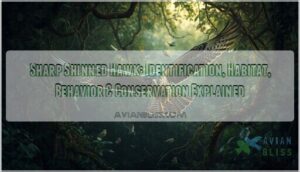This site is supported by our readers. We may earn a commission, at no cost to you, if you purchase through links.
A flash of blue-gray wings cuts across the understory, scattering songbirds before the sharp-shinned hawk melts into the shadows. This sleek hunter thrives in the tangled heart of the forest, where its keen yellow gaze and needle-thin talons mark it as a master of pursuit.
Stealth shapes every move—each ambush, each silent dive, every twist between branches. Understanding how the sharp-shinned hawk claims its patch of sky and forest reveals more than habit or habitat; it exposes a species built for agility and survival.
These insights signal a challenge and an invitation—to study resilience under wild canopies.
Table Of Contents
- Key Takeaways
- Sharp-Shinned Hawk Identification
- Habitat and Geographic Range
- Behavior and Hunting Techniques
- Breeding and Nesting Habits
- Conservation Status and Challenges
- Frequently Asked Questions (FAQs)
- Are Sharp-shinned Hawks rare?
- What do Sharp-shinned Hawks eat?
- Are Sharp-shinned Hawks aggressive?
- Why are they called Sharp-shinned Hawks?
- Is a Sharp-shinned Hawk a falcon?
- How do Sharp-shinned Hawks use bird baths?
- What is the history of Sharp-shinned Hawks in Pennsylvania?
- How long do sharp-shinned hawks typically live?
- Do they return to the same nesting sites?
- What diseases commonly affect sharp-shinned hawks?
- Conclusion
Key Takeaways
- Sharp-shinned hawks are agile forest raptors, distinguished by blue-gray backs, orange-red barring, short rounded wings, and striking yellow eyes.
- These hawks thrive in dense woodlands but also adapt to urban edges, using stealthy ambush tactics and fast maneuvering to hunt mainly small songbirds and rodents.
- Females are noticeably larger than males, and juveniles can be identified by their brown streaked plumage compared to the adults’ more patterned gray and rust feathers.
- Though not rare, they face challenges from habitat loss and climate change, making ongoing monitoring and citizen science efforts key to their conservation.
Sharp-Shinned Hawk Identification
Ready to spot a Sharp-shinned Hawk in the wild? Start by knowing exactly what features set this raptor apart from the crowd.
Let’s break down the key traits you’ll want to recognize next.
Key Physical Characteristics
Take a close look at Accipiter striatus and you’ll see a masterclass in raptor identification. The Sharp-shinned Hawk’s plumage patterns—blue-gray back, orange-red barring—contrast with piercing yellow eyes and a sharp, hooked beak.
Short, rounded wings and pencil-thin talons pack speed into a small frame. This hawk’s feather color and wing structure set it apart, bold and unmistakable.
Distinguishing From Similar Hawks
Raptor Identification isn’t just about sharp eyes—it’s about awareness. When you line up Sharpshinned Hawk against Cooper’s Hawk, Hawk Size Variations and Wing Shape Comparison instantly come into play. Shorter tails, slighter frames, and more squared tail feather distinctions mark Accipiter striatus.
Watch for nuanced Feather Pattern Differences and even Beak Structure Analysis in honing your Hawk Identification Techniques.
Juvenile Vs. Adult Plumage
Hawk identification isn’t a game for the impatient—especially with the Sharp-shinned Hawk. Age determination hinges on nuances: juvenile plumage patterns show brown-streaked upperparts, while adults wear slate-gray with rusty barring. Watch for these clues:
- Molt timing blurs boundaries, sometimes mixing feather replacement across age groups
- Coloration changes kick in by the second year
- Mixed-stage birds challenge even rigorous hawk identification techniques
Size and Sexual Dimorphism
Spotting gender differences in Sharp-Shinned Hawks is all about morphometric analysis—these Accipiter hawks break the rules with their size ratio. Females tower over males, with about a 15–25% size gap. This dimorphism affects everything from diet to territory, etching clear lines between the sexes.
| Sex Ratio | Size Variation |
|---|---|
| 1:1 balanced | Female 15–25% ↑ |
| Morphometric Data | Dimorphism Effects |
Habitat and Geographic Range
Where you find the sharp-shinned hawk depends on both the season and the landscape. From wild forests to city edges, this raptor thrives in a surprising range of places.
Let’s look at the habitats and regions where you’re most likely to spot one.
Preferred Forest and Woodland Habitats
Ever wondered what draws a sharp-shinned hawk to a patch of forest? You’ll find them weaving through dense canopies where woodland ecology offers both cover and endless prey. Their favorite habitats share these traits:
- Mixed coniferous forests rich in mature, patchy stands.
- Deciduous tree dominance with tangled thickets.
- High understory density for stealth.
- Minimal habitat fragmentation—cohesive woodlands mean more hunting success.
That’s their winning formula.
Migration Routes and Wintering Areas
Across the continent, sharp-shinned hawks follow a lattice of flyway patterns stretching from Alaska’s boreal forests to Central America’s wintering grounds. Migration timing is orchestrated by food pulses and wind—a living map of avian migration. Stopover sites—riparian forests and woodland edges—offer quick cover, essential prey, and habitat connectivity for these fierce migrants.
| Corridor | Timing | Key Stopover Habitat |
|---|---|---|
| Pacific Flyway | Aug–Oct | Conifer–deciduous woodlands |
| Great Lakes | Sep–Nov | Riparian forest edges |
| Atlantic Flyway | Sep–Nov | Mixed-age upland forests |
| Sierra Nevada | Sep–Oct | Canopy breaks, creek valleys |
| Gulf/South-Central | Oct–Nov | Woodland fragments |
Presence in Urban and Suburban Environments
Along the tangled edge of suburb and city, Sharp-Shinned Hawks reveal just how adaptable wild instincts can be. These Urban Hawks slip through patches of woodland and perch on fences, keeping Suburban Habitats in their hunting sights. With City Prey abundant and riparian edges offering cover, your own backyard may become a stage for their survival drama—a signal that urban wildlife conservation matters.
- Glimpse raw predatory skill amid city sprawl
- Witness unexpected Backyard Encounters in flight
- Feel the wild pulse behind familiar bird species
Behavior and Hunting Techniques
Every sharp-shinned hawk has its secrets, especially regarding the hunt. If you’re curious how these raptors outsmart their prey, you’re in the right place.
Let’s walk through the key behaviors and hunting techniques that set them apart.
Primary Diet and Prey Selection
Think you know what a sharp-shinned hawk eats? Think again. As one of North America’s most agile raptors, its diet composition is dominated by small songbirds and rodents, adapting prey size variance from sparrows to voles.
This bird of prey’s foraging strategies and prey capture techniques yield variable hunting success rates, shaping predator–prey relationships in forests and backyards alike. It’s a relentless pursuer, thriving where opportunity knocks.
Hunting Strategies and Adaptations
Locked onto the chase, you’ll find the sharp-shinned hawk perfectly engineered for surprise and acceleration. Ambush Tactics rule in dense forests, while Pursuit Methods adapt as opportunities shift. This raptor’s nimble wings and adaptive behavior let it twist through tangled habitat, exploiting prey selection from songbirds to small mammals. Hunting Speed isn’t just brisk; it’s a calculated assault—redefining hawk behavior and habitat mastery.
- Agile, short wings improve tight cornering
- Prey Selection spans diverse small birds
- Adaptive Behavior maximizes hunting success in forests
- Stealth approach distinguishes this bird of prey
- Hunting Speed surges in migratory stopovers
Role in Bird and Small Mammal Populations
Ever wondered how the SharpShinned Hawk keeps nature’s scales in check? Its prey selection directly shapes ecosystem balance, with predation impact ranging up to 20% of daily juvenile songbird mortality in hotspot habitats. This raptor’s hunting fuels population dynamics, reshaping avian ecology and mortality rates. Predator-prey relationships here reveal why wildlife conservation hinges on recognizing the hawk’s subtle influence over ecology and biodiversity.
| Aspect | SharpShinned Hawk Effect |
|---|---|
| Predation Impact | 2–20% small bird loss |
| Population Dynamics | Alters prey age structure |
| Ecosystem Balance | Regulates small mammals |
| Mortality Rates | Spikes during migration |
Breeding and Nesting Habits
Curious about how Sharp-shinned Hawks raise their offspring? Let’s walk through how they find nesting sites, handle breeding, and support their young.
Here’s what you’ll want to know about their breeding and nesting habits.
Nest Site Selection and Construction
Nest Tree Selection drives the Sharp-shinned Hawk’s approach to stealth: these raptors choose elevated, concealed spots—often mature conifers—where prey is plentiful. Nest Architecture favors forks or sturdy branches, capitalizing on protective cover.
Site Preparation is careful, as both sexes craft modest platforms using bark flakes and pine needles.
For those dedicated to Wildlife Conservation, understanding how Nest Placement and Tree Species affect nesting is critical to sustaining vibrant bird habitats.
Breeding Season and Parental Roles
Once the nest is secure, Breeding Behaviors come alive: Sharpshinned Hawk pairs synchronize courtship flights and vocal exchanges, setting territory boundaries. Mating Strategies play out from late March, with timing tweaked by spring warmth.
You’ll notice the female dominates Parental Care—incubating eggs, brooding hatchlings—while the male cranks up provisioning. High Nest Success Rates depend on this fluid division of labor, anchoring bird habitat and Hawk Species resilience in shifting Avian Ecology.
Fledgling Development and Survival
While the female guards the young and the male continues his relentless foraging, sharp-shinned nestlings accelerate through developmental stages—from blind, downy hatchlings to feathered fledglings in just four weeks.
Fledgling Mortality remains high, with Survival Rates tied to rapid Nestling Growth and luck during Juvenile Dispersal.
Agile yet inexperienced, they navigate predation, competition, and a steep learning curve—a crash course in avian behavior shaping future bird species identification.
Conservation Status and Challenges
Every wild population faces its own set of hurdles, and sharp-shinned hawks are no exception. If you’re curious about the challenges these birds encounter, you’re in the right place.
Let’s look at the main factors shaping their future.
Population Trends and Monitoring
Think raptor population dynamics are a guessing game? Not so. Sharp-shinned Hawks tell a story of resilience—annual population fluctuations charted through banding data, the Raptor Population Index, and species monitoring by HawkWatch International.
Migration patterns remain stable, despite regional shifts. IUCN conservation status lists them as Least Concern, but wildlife conservation status is anchored by ongoing surveillance and adaptive conservation metrics—each a lifeline against subtle habitat fragmentation.
Threats From Habitat Loss and Climate Change
Under the shadow of Habitat Fragmentation and relentless Climate Shifts, your sharp-shinned hawks navigate a thorny thicket of challenges. Here’s how these stressors manifest:
- Core breeding-range contraction from Habitat Degradation
- Ecosystem Disruption driving prey instability
- Biodiversity Loss at the woodland edge
- Environmental Degradation shrinking migratory corridors
- Raptor Conservation hindered by unpredictable weather patterns.
This is the front line of ornithology and bird study.
Conservation Efforts and Citizen Science
With every migration season, you hold front-row seats to the evolving story of sharp-shinned hawks, thanks to the synergy between Citizen Research and professional ornithology. Community Engagement drives Wildlife Monitoring—counting, tracking, and sharing data. In your hands, raw sightings fuel thorough Data Analysis, helping conservation organizations develop adaptive Conservation Strategies.
Each migration season, citizen engagement and ornithology combine to transform your sharp-shinned hawk sightings into powerful tools for conservation progress
| Citizen Science | Fieldwork Insights | Raptor Conservation Outcomes |
|---|---|---|
| Migration counts | Nest monitoring | Improved habitat plans |
| Photo mapping | Clutch surveys | Policy recommendations |
| Crowd reporting | Fledgling results | Ecological Conservation gains |
Frequently Asked Questions (FAQs)
Are Sharp-shinned Hawks rare?
Spotting a SharpShin is like catching a shadow in motion—never easy, yet they’re not truly rare. Regional Population Trends show stable numbers, so despite local Habitat Fragmentation or Conservation Threats, the IUCN Status remains Least Concern.
What do Sharp-shinned Hawks eat?
Prey selection for SharpShin hinges on small songbirds—they’re masters of ambush. With swift hunting tactics, they track prey through dense cover, shaping predator-prey relationships and food chains that define hawk species’ dietary habits and broader bird predation dynamics.
Understanding these dynamics requires reviewing AP study resources to gain insight into ecological concepts.
Are Sharp-shinned Hawks aggressive?
Imagine a swift shadow passing overhead: Sharpshinned Hawks aren’t usually aggressive. Rather than Hawk Attacks, you see Defensive Tactics—brief pursuits or warning calls—focused on protecting nests or outmaneuvering prey, never targeting humans or pets.
This behavior can be related to human emotional responses.
Why are they called Sharp-shinned Hawks?
The name Sharp-shinned Hawk draws from its sharply scaled, fine feathered tarsi—a standout trait among Accipitridae.
This naming convention highlights etymological significance, aiding quick field identification and emphasizing distinct Sharpshinned Hawk characteristics versus similar hawk species.
Is a Sharp-shinned Hawk a falcon?
Despite the name, Sharp-shinned Hawks aren’t falcons. They fall under Accipitridae, unlike true falcons such as Merlins.
Compared to falcons, their flight patterns showcase more agile weaving—classic for accipiter hawk classification and raptor distinctions.
How do Sharp-shinned Hawks use bird baths?
It’s no accident you’ll find Sharp-shinned Hawks at urban water features. These raptors use bird baths for quick hydration, not lengthy baths—often lurking near these water sources, seizing opportunities to ambush prey visiting for a drink.
What is the history of Sharp-shinned Hawks in Pennsylvania?
Historic migration through Pennsylvania is well documented, with Sharpshinned Hawk counts peaking each fall. Rare PA breeding occurs in high-elevation blocks, while forest fragmentation and regional trends shape ongoing hawk conservation, bird ecology, and habitat preservation efforts.
How long do sharp-shinned hawks typically live?
You’ll find most sharp-shinned hawks out in the wild living around four to five years, though a lucky few break the mold, pushing eight to ten.
Lifespan factors include habitat impact, survival strategies, and shifting longevity trends.
Do they return to the same nesting sites?
Picture the quiet return each spring—nesting site fidelity in this bird species is striking. Sharpshinned Hawks exhibit strong nest reuse patterns, often returning to previous breeding territories, especially where habitat stability offers rich, unbroken cover along familiar migration routes.
What diseases commonly affect sharp-shinned hawks?
You’re traversing a landscape where Avian Influenza, West Nile Virus, Trichomoniasis, Avian Pox, and Fungal Infections frequently emerge—these diseases shape ornithology, drive wildlife conservation efforts, and sharpen our understanding of bird conservation and ecology.
Conclusion
Somewhere, just beyond the reach of your gaze, the sharp-shinned hawk drifts through shadow with graceful ease. Every feather, every silent approach reminds you: mastery in the wild is never a guarantee—it’s an ongoing pursuit.
Let your curiosity cut through old assumptions, like wings threading branches, and you may glimpse new possibilities hidden within familiar woods.
The secrets of this aerial predator don’t surrender easily, but those who chase them discover the forest anew, every single time.












